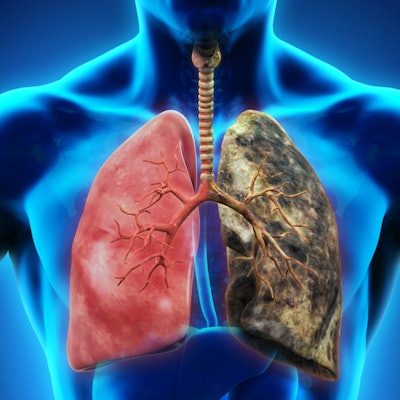
The U.S. Preventive Services Task Force (USPSTF) has reopened for review its guidance on CT lung cancer screening. Should radiology be concerned that the group could soften its current support for the exam? Lung screening expert Dr. Ella Kazerooni offers her take on the topic.
 Dr. Ella Kazerooni from the University of Michigan.
Dr. Ella Kazerooni from the University of Michigan.
The USPSTF is essentially asking, "Does CT screening in practice perform at least as well as it did in the National Lung Screening Trial?" Kazerooni told AuntMinnie.com. She serves as chair of the American College of Radiology's (ACR) Lung Cancer Screening Committee and of the American Cancer Society's (ACS) National Lung Cancer Roundtable. Kazerooni was also recently appointed interim chair of the radiology department at the University of Michigan.
"Though the number of CT lung cancer screening sites is increasing and the number of screens is slowly and gradually increasing, not enough screening has been done yet to fully answer this question," she said. "The text the USPSTF has put together for its review represents what we need to know in order to drive effective research in that regard."
New research plan
Multiple clinical trials assessing CT lung cancer screening have emerged since 2013, when the USPSTF released a draft guidance recommending the screening test for adults 55 to 80 years old who have a smoking history of 30 pack-years and still smoke or have quit within the past 15 years.
As five years have passed since then, the USPSTF has drafted a fresh plan to help guide its upcoming systematic review of many of these CT lung cancer screening studies.
"The reason for the new research plan is the usual and appropriate thing, which is that the USPSTF reviews all of its recommendations on a regular cycle, and lung cancer screening was up for review," Kazerooni said.
The research plan consists of several sections, including the following:
-
Key questions for systematic review: There are eight key questions aimed at evaluating a wide range of concerns, from the accuracy of CT lung cancer screening and its various harms and benefits to its effect on cancer incidence, staging, and mortality.
-
Contextual questions: These questions spotlight issues such as the appropriateness of the targeted population, the survival rate of these individuals, barriers to screening, and any unintended benefits of incidental findings on CT.
" 'What are the barriers to implementation of screening for lung cancer?' is probably one of the most important questions they can ask right now," Kazerooni said. "Just why are we seeing such slow uptake?"
One of the possible barriers to CT lung screening is the lack of an appropriate structure, which includes computer software for identifying nodules, as well as a designated nurse navigator or practitioner in charge of managing the program, she said in response to this question. Not having these basic infrastructure investments in people and tools prevents practices from developing and growing their screening programs.
-
Analytic framework: The USPSTF has issued a flowchart that illustrates the major components of CT lung cancer screening that are addressed by the key and contextual questions.
-
Research approach: The approach provides detailed information on the type of trials the USPSTF is looking for, Kazerooni noted.
-
Decision model: "The proposed decision model is consistent with approaches they used last time, which involves a sound methodology," she said.
Too early to answer
The number of lung cancer screening sites enrolled in the ACR registry increased from roughly a little over nine sites in 2015 to more than 2,000 in 2016, with another 517 added in 2017.
Despite this proliferation, there still isn't enough evidence to fully address many of the questions posed in the USPSTF's research plan, including concerns about the effectiveness of CT screening and its impact on lung cancer mortality for subgroups defined by age, sex, race, etc., according to Kazerooni.
"The plan includes a solid framework and a good set of questions," she said. "But not enough people are being screened to know in practice what the overall impact has been. I don't think there's enough new clinically available data to inform a major change in the current guideline. It's still too early to answer."
Most of the recent trials in the U.S. and Europe have been too small to identify better age and smoking history requirements for participants than the ones already established by the National Lung Screening Trial (NLST), Kazerooni noted. Future analyses of results from the ongoing Dutch-Belgian Randomized Lung Cancer Screening (NELSON) trial may help to that end.
However, Kazerooni does recognize the potential advantages of taking into account individual risk factors when deciding who should undergo CT lung cancer screening.
"Currently, we screen based on age and pack-years alone," she said. "We know that there are other factors such as family history, emphysema, and chronic obstructive pulmonary disease, as well as radon, asbestos, and other environmental exposures, and yet none of those factors are considered for people whom we screen. We are interested in moving toward individual risk assessment at some time in the future."
Several studies have demonstrated the benefits of adjusting the qualifications for participating in lung cancer screening based on risk-prediction models, but the rub lies in being able to discern which of the numerous competing models is the right one.
Potential changes
Even though the USPSTF supported CT lung cancer screening in the group's previous recommendation in 2013, any new doubts, should they arise, could rekindle the heated debate over payment coverage for screening that occurred five years ago.
Indeed, controversy prevailed back then over whether the U.S. Centers for Medicare and Medicaid Services (CMS) should pay for CT lung screening. The Medicare Evidence Development and Coverage Advisory Committee (MEDCAC) advised against payment coverage for CT lung cancer screening, but CMS decided to override that decision and include the test as a preventive service benefit under Medicare.
"If the USPSTF were to downgrade its classification to below a grade of B, that would mean that Medicare coverage under the Patient Protection and Affordable Care Act would go away, which would be problematic," Kazerooni said. "We hope this does not happen; we hope they will maintain their grade B recommendation."
On the other hand, if the goal of the USPSTF is to look at the barriers that have been keeping screening participation low to summarize and, ultimately, help overcome them, that's great, she noted.
"It's very important that interested parties review the plan and leave their comments as to what they think is appropriate [for CT lung cancer screening], and what kind of information they think is important for the USPSTF to consider," she said.
The draft research plan is available online and open for public comment through May 30, 2018.




















